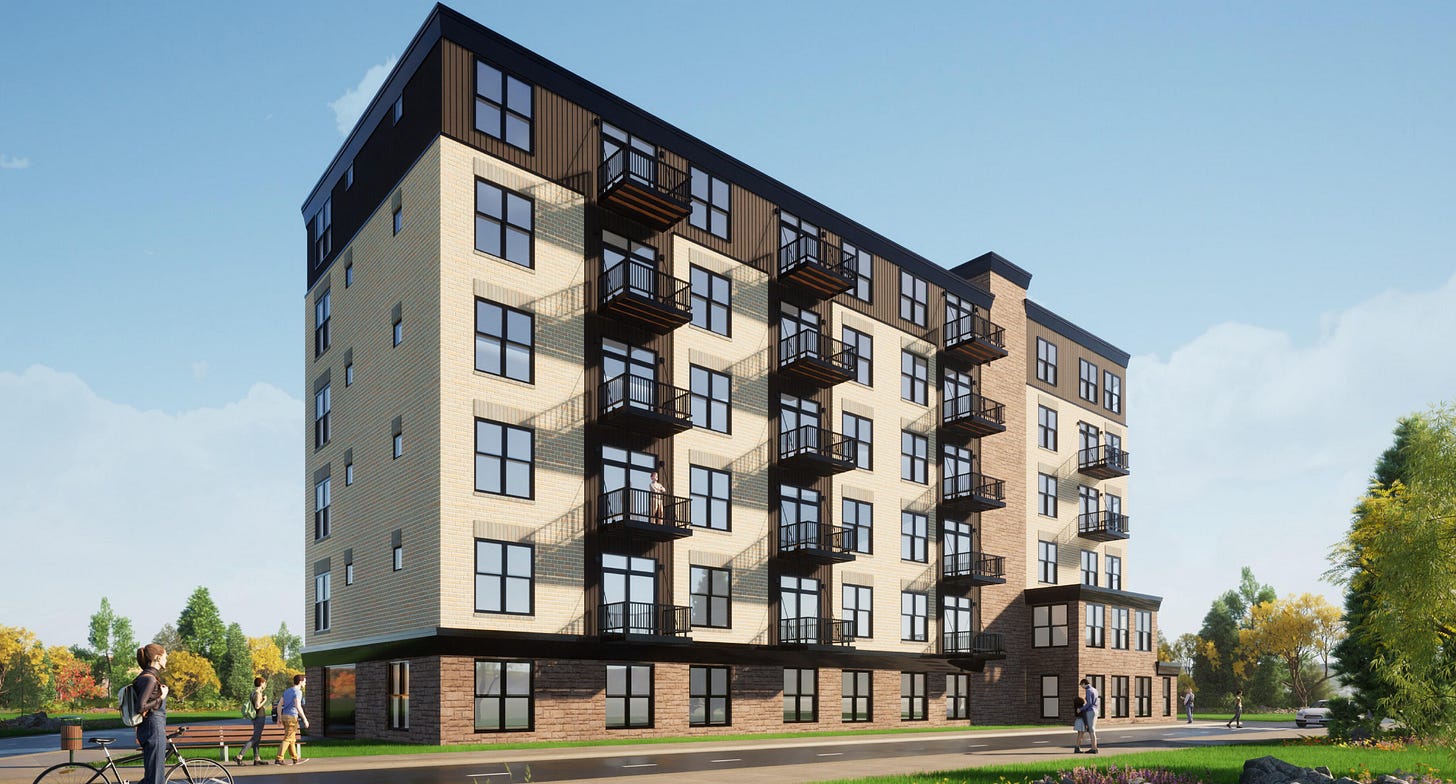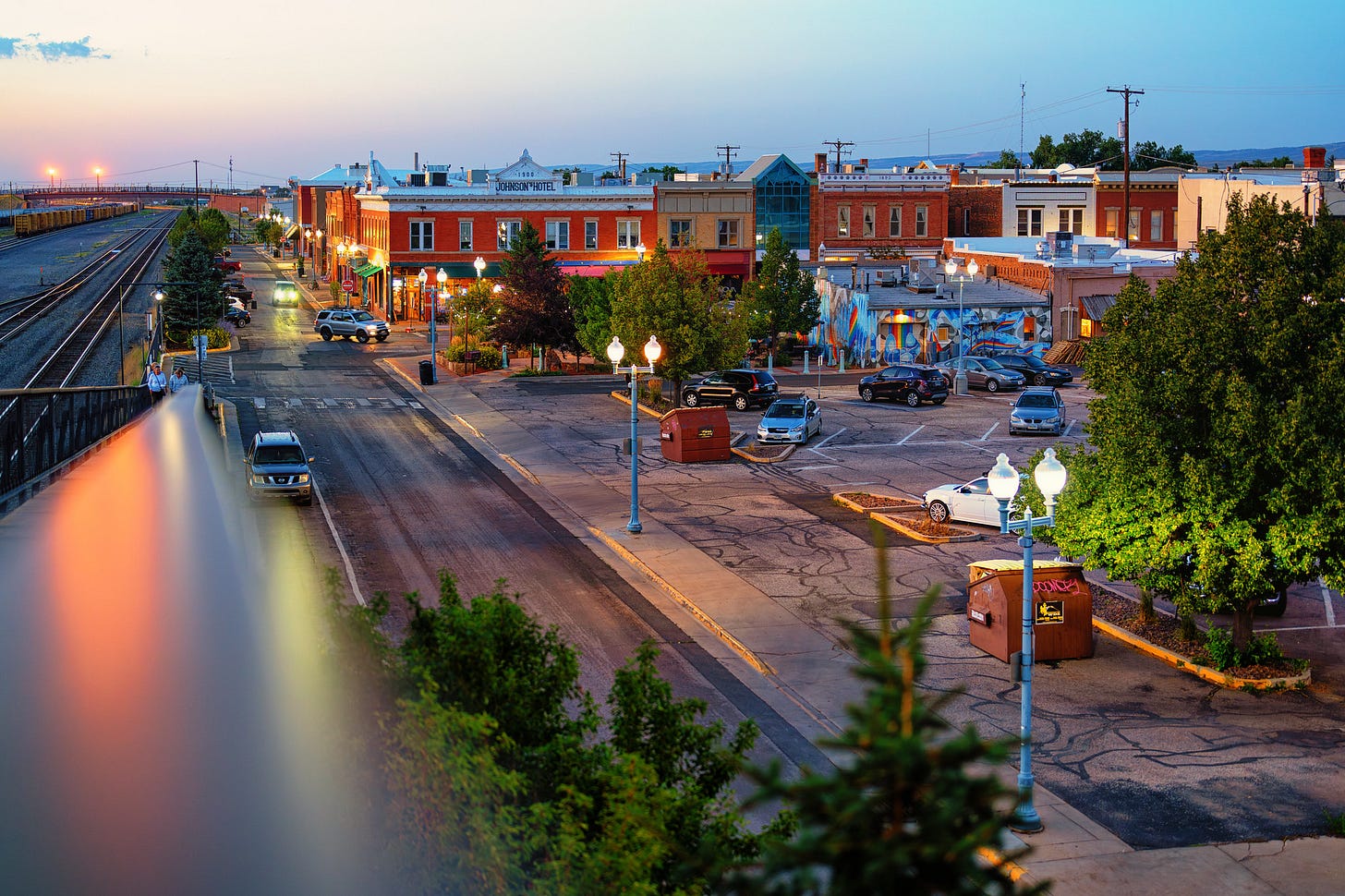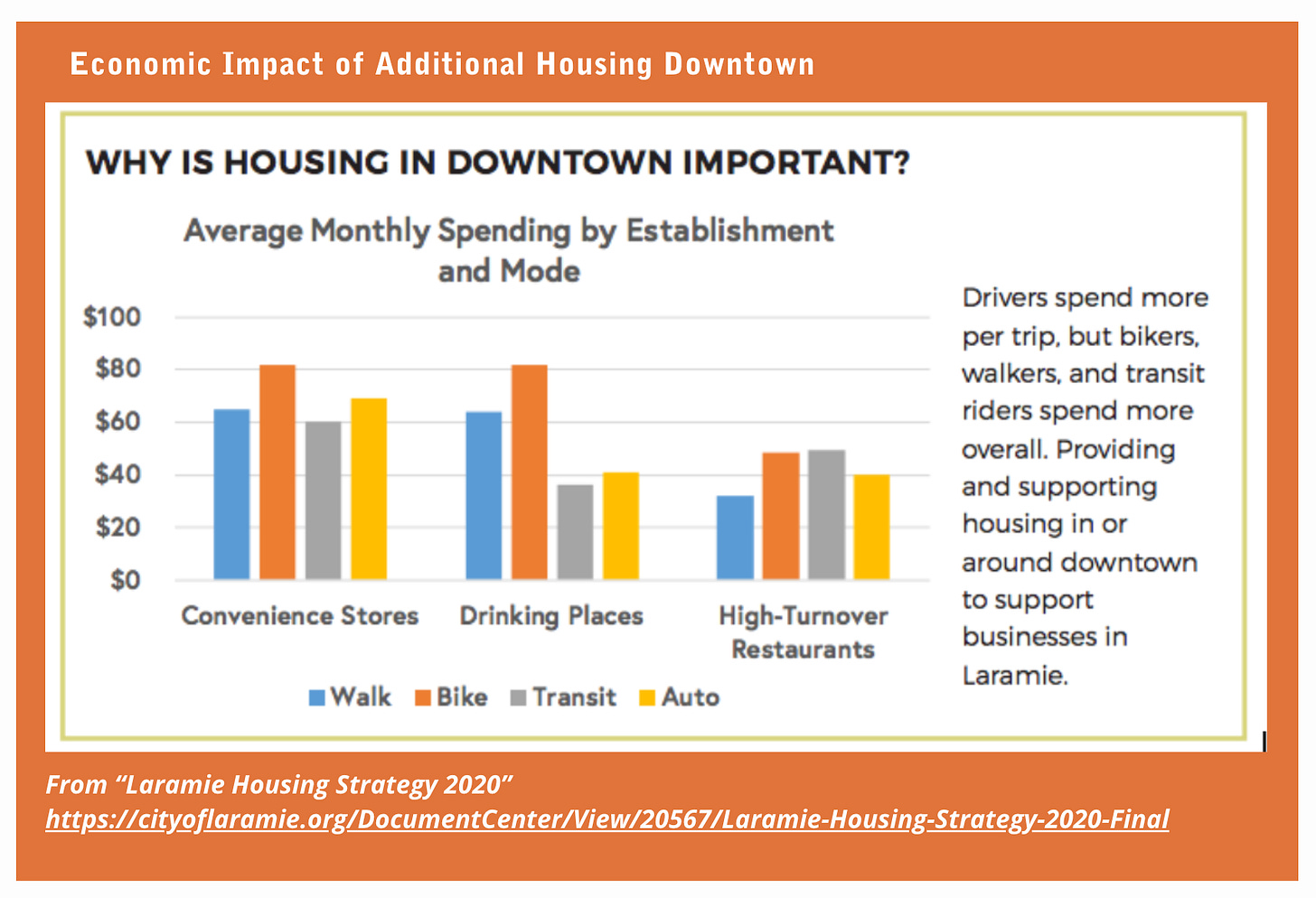Laramie saves a First Street parking lot, blocking the apartments that could have taken its place
A 50-year agreement establishes the Bolton parking lot as mostly public. But the city briefly considered nixing the agreement to make way for downtown housing, a commodity Laramie desperately needs.

The Laramie City Council voted to uphold a parking agreement that currently stands between a would-be developer and the six-story downtown apartment complex he was seeking to build.
The apartments were planned for the Bolton lot, the parking area along First Street behind Coal Creek Coffee and TAP. It would have eliminated about seven percent of the public parking available downtown.
That realization sparked a firestorm of debate across virtual and in-person forums that has raged since the council first considered the proposal last month.
The Laramie City Hall council chambers were packed Tuesday night as dozens of residents, many of them downtown business owners, came out to oppose the apartment’s construction.
“For the second week in a row, we’ve heard largely the same things,” Mayor Brian Harrington said following more than an hour of public comment. “We’re hearing what you’re saying.”
The council was not voting on the development itself. Instead, the council voted to maintain a parking agreement that currently blocks the development from taking place.
The Bolton lot currently cannot be developed because of an agreement between the property owner and the city that preserves that lot, or most of it, for public parking. That compromise is known as the Landmark Square Agreement.
Before the council Tuesday was a proposal to terminate the agreement, an action that would have enabled the development to proceed. But the councilors voted 6-3 to uphold the parking agreement, thereby blocking the construction.
So the parking lot is safe, at least for now. But this specific proposal, or other proposals for the same lot, could return. Some councilors signaled they would be more willing to consider terminating the agreement if there was a more concrete plan in place for the apartments or for another structure they felt served the city.
One way or another, the city is slated to lose most of its control over the future of that lot, which is privately owned, in two decades’ time when the Landmark Square Agreement expires. Harrington said he hopes an alternative plan can be found and approved before then to avoid the worst possible outcomes.
“This could be a Target, right? Like this could be a McDonald’s drive-thru,” he said. “To me, those are consequential because you lose the parking, but without any of the benefits. And so I just wanted to maybe reiterate the complexity of the decision we’re trying to make.”
Downtown advocates have been pushing to expand housing options in the area, by renovating unused second and third floors and through new construction projects. The 88-unit, six-story apartments would have brought the city within reach of its 2030 goals for downtown housing buildout.
Public parking, private property
From the alley to First Street, the relevant block is divided between two property owners.
Most of that half-block, including the parking lot itself and First Street Plaza, is owned by Ryan Bolton, while John and Jodi Geurin, the owners of Coal Creek Coffee and TAP, own both the Coal Creek footprint and a sliver on the far side of the parking lot bordering Garfield Street.
The Landmark Square Agreement, which establishes the public parking lot, exists between the city and Bolton, and was first signed in 1994. While Bolton is still the legal owner of most of the lot, the city maintains it, and members of the public are free to use it for parking when they visit downtown.
Bolton now wants to sell his property to the Stencil Group, the apartment’s would-be-developer, and had requested the city release him from the agreement — 20 years ahead of its planned expiration in 2044. Nathan Stencil, the CEO of the development firm, attended the meeting Tuesday via Zoom to say he believed in the project but wanted to know if it would even be viable.

“Our goal is to never come into a community and just push a deal forward,” he said. “The first phase of doing this was really to understand if we could even have an opportunity to terminate this lease agreement.”
The city council first considered terminating the Landmark Square Agreement during a work session called for that express purpose late last month. The councilors heard overwhelmingly from residents, mostly downtown business owners, who asked the city to keep the agreement in place.
On Tuesday, the council met again, this time for a regular meeting, and could have voted to terminate the agreement, postpone the decision, or outright refuse to terminate it, ensuring that the parking lot would remain. Councilors took this last option, motivated by the outpouring of opposition that flooded both meetings about the topic.
Parking, parking, parking
The most frequent complaint about the project — and therefore the most frequent defense of the Landmark Square Agreement — was about parking.
The apartment complex would be built on a lot that currently provides 78 parking spaces, most of them public. The early conceptual plans for the complex included a ground-floor parking garage with more than 60 spaces, but those would have been reserved for residents. The developer said his firm would have endeavored to add about 20 on-street public parking spaces to account for some of the spaces eliminated by the new construction.
But downtown business owners were not impressed with that offer, arguing that having ample parking in the downtown area is crucial to many of their businesses.
“A parking lot full of cars is a beautiful sight and indicative of customers in your business,” Bent & Rusty owner Bille Eckhardt told the council Tuesday. “We don’t clog all the open spaces with buildings without considering the optimum ratio of parking spaces to businesses for their success.”
Eckhardt has been vocal about her opposition to the development, arguing variously that downtown is not the right place for new housing or baselessly asserting that this development in particular might be the first step to establishing a “sanctuary city” for refugees. (City Manager Janine Jordan refuted this claim at the outset of the council’s discussion Tuesday, saying, “I want to assure the public that the developer has never discussed at any time anything about this project in any way remotely related to sanctuary cities, and councilors, you know, you've never ever ever had that conversation.”)

Eckhardt recognized there might be a tension between private property rights and keeping a property owner locked into an agreement they now want out of. But she noted Bolton is free to sell the lot to another owner; he simply can’t develop it.
“Nobody wants the government telling them what they can and can’t do with their property,” Eckhardt said. “However, in this case, Ryan Bolton purchased this property … with this lease in place. He was aware that land was locked into a lease with the city until 2044.”
While other commenters mentioned the potential health consequences of siting homes so near to train tracks or the need for ample accessible parking, most arguments focused on the general parking this development would eliminate and the impact that would have on the area.
“I love our downtown; I think it’s beautiful, vibrant, thriving, and it’s unique,” said Caley Myers, owner of Art & Soul Pottery Studio. “I’m all for progress and growth and also changing with the times and evolving with the times. But I do believe with my whole heart that this apartment complex will be devastating for downtown Laramie.”
Myers said having sufficient parking close to her business was crucial in her everyday life.
“Parking is a huge issue already,” she said. “I unload carfuls of pottery every single week. And I drive around and drive around and drive around until I find a spot where I can unload that pottery. So it’s already a problem.”
Myers added that her sister, who has cerebral palsy, accompanies her to work frequently and makes use of the one accessible parking space near Art & Soul. Myers said she was worried that further reducing the number of ADA-compliant parking spaces downtown would make visiting the studio even more difficult for her sister.
Housing, housing, housing
The flip side to all of this is that Laramie needs housing.
Laramie’s 2015 Housing Study found that the city would need to add more than 1,500 residential units by 2020 and more than 4,100 by 2030. Laramie has missed the 2020 target and is not on track to hit its 2030 goal, having added just 602 new units since 2015.
“The most critical housing issues in the city include promoting the development of housing for the local workforce, college students and young professionals, affordable to all salary income levels and at a pace that will equal the demand of a rapidly growing community,” the study notes. “Other priority housing needs include providing housing opportunities for the elderly, first-time homebuyers, middle-income persons and families and persons with special needs.”
The city has recently altered its zoning laws to encourage more development, for example by allowing denser housing to be built in multi-family zones and legalizing accessory dwelling units in single-family zones. But there has also been a push, spearheaded by the Laramie Main Street Alliance, to add more housing downtown.
The 2015 housing study calls on the city to hit at least 210 downtown housing units by the end of this decade. Currently, there are less than half of that. The apartment complex proposal blocked by councilors Tuesday would have added 88 units, bringing the city within reach of that 2030 goal.
For this reason, Laramie Main Street Alliance submitted a letter of support to the city council, urging them to release Bolton from the Landmark Square Agreement and clear the way for the construction of the downtown apartment complex.

The letter points to Laramie Main Street’s own research showing that drivers might spend more per trip, but walkers, cyclists and those using public transit spend more overall and that those living downtown will frequent businesses near their home.
“Downtown residents support homegrown economic development and a robust economy by spending their income in locally owned businesses that are walkable from their living unit,” the letter states. “They are vested in the success of the district, either as workers or consumers, reinvesting in the place they call home.”
Laramie Main Street estimates that a downtown resident renting a unit for $750 per month would spend more than $8,000 a year in the downtown area, buying groceries, meals, clothing, entertainment and more from businesses within walking distance of their front door.
Neither Trey Sherwood, the organization’s executive director, nor any other representative of Laramie Main Street spoke during the meeting Tuesday.
How one councilor changed her mind
Among the six councilors who voted to uphold the parking agreement was one who had previously been vocal about the need to rethink our culture’s reliance on cars.
During the work session last month, Councilor Micah Richardson reminded the public that Laramie is severely short on houses and that businesses frequently back out of moving operations to Laramie because of the housing shortage.
“I honestly think we have a walking issue more than a parking issue,” she said. “We’ve got to start to understand that walking four or five blocks is okay … To me, housing people and giving people a place to be and bringing more businesses to our community will likely override the need for parking.”
And yet, Richardson voted to maintain the parking agreement.
“When the project first was presented, I was really excited about the opportunity because housing is a huge issue,” she explained to the Laramie Reporter after the meeting Tuesday. “That’s kind of where my head was when I first started in on all of this. Then the council received such an overwhelming amount of feedback saying that people didn’t want a six-story building.”
So at the outset of yesterday’s meeting, Richardson was leaning toward a postponement vote, delaying the council’s decision to allow for a more concrete plan to come together, to bring everyone to the table and work out some sort of compromise. But at that point, she was set against simply taking the reins off and letting the development proceed unfettered.
“It didn’t feel like just terminating the lease was necessarily the right thing to do,” Richardson said. “It just didn’t feel like we had necessarily all the information that was needed.”
But the public comments were largely one-sided and it became clear that there probably wouldn’t be much wiggle room in which to find a compromise.
“After listening to the overwhelming amount of opposition, and knowing that a six-story development was not necessarily what council was comfortable with either — and then getting the sense that the developer was pretty set on this build, even if not the design — postponement no longer felt like the best direction,” Richardson said.
Swayed by the vocal opposition, Richardson voted to uphold the parking agreement. But she still wonders if she made the right call. And she said she’s no less committed to supporting housing development in Laramie.
“If we tell developers, ‘No, we don’t like this’ — what's the likelihood that they’re going to come back to any location in town?” she said. “And that’s what also makes it such a difficult decision. We know we need the housing. I know we need the housing, I want to support that. But also trying to balance what we’re hearing from so many people can be tricky.”
As for her comment about Laramie having a “walking problem” rather than a “parking problem” — a comment several business owners brought up and criticized Tuesday — Richardson said she could have worded it better by recognizing that walking is not an option for everybody every time.
“But I think that's exactly my point,” Richardson said. “Those of us who can walk, and are perfectly capable and really have no reason not to, we should be parking farther away, so that those folks — the ones who struggle to find a parking spot because maybe they’re elderly or because they’re a business owner who’s trying to bring in loads of things — can have those spaces. If we can start to be okay with walking a little further, that’s going to help some of this.”
Building more walkable, pedestrian-friendly cities has positive effects on public health, mental health and the environment. Laramie’s already doing well on this front. When it comes to travel by means other than a car, Laramie is considered “very walkable,” with a Walk Score of 88, and extremely bikeable with a perfect Bike Score of 100.
But building and maintaining walkable cities requires more than infrastructure; it also requires a culture shift away from the assumption that cars are the only or best way to travel within a city. And Richardson would like to see movement on that front as well.
“As Wyomingites, I think we just grow up learning that you drive everywhere,” she said. “Things are spread out — you think about some of our towns and the distances [between]. We don’t have public transit. We don’t have any of those things that get you in a frame of mind that’s like: ‘Let’s go ahead and walk.’”




Remember Sports Locker (and its 100+ parking spots) that STILL went out of business. - - - But lets keep caving to the downtown business owners who were happy to set up shop there, despite limited spaces.
Nicely done as I think it expresses all issues rationally. Having the graphic also helps. I understand the votes as well. I am kind of flabbergasted about the visceral response against this proposal. The impacted footprint is in the perfect spot to make Laramie a more vibrant and thriving community.
I actually love the cold opening of this proposal as it is perfect and perfectly placed. The people against have concerns that could be addressed easily as part of the negotiation concerning the conditions of the release.
Remember this is a rival of "historic" downtown as this parking lot was once filled with buildings that the city fathers and building owners thought would be more profitable to both to pave over these "historic" structures. That history should tell you how pessimistic and desperate the owner and the city were when that deal was struck. I have explanations on why America thought downtowns had no future and they are now shocked that perception was false.
If I were the Enlightened Despot of Laradise I would approve of this proposal as long as they met my none self serving conditions.
You know what else I love about this issue is that Laramie already solved its gravel pit problem (Pilot HIll anyone) and now we are working on this noble quest.